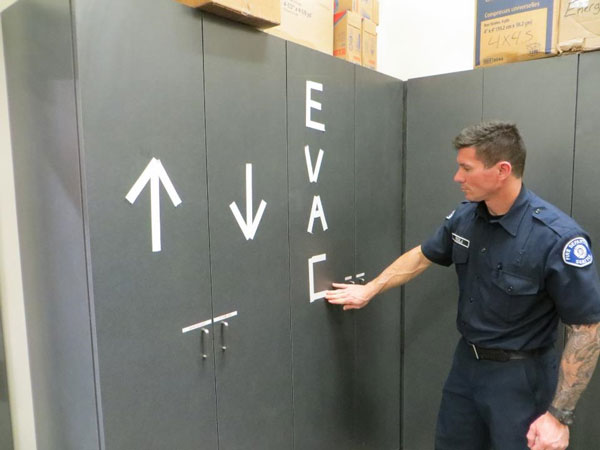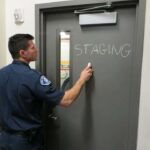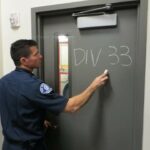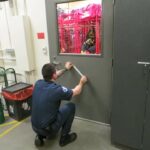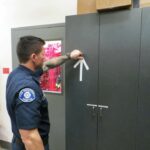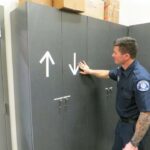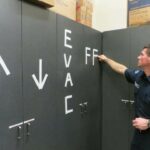
By Raul Angulo
I am humbled with the popularity of this subject–it obviously has resonated with firefighters. What started out as a small class continues to grow. Let’s get right to it: so far, there are more than 100 drills, but we’ll take one at a time. For the format, I will have one company officer instructor tip (one slide) and then get right to the drill.
The photos are shot in sequence and are easy to follow. CLICK HERE for the complete drill.
Company Officer Tip
I like to start by asking these three questions:
- What type of atmosphere do you create when you drill?
- Is it conducive to learning?
- Does your crew dread training?
Take a self-assessment and be honest, ok? If you can’t be honest with yourself, ask your most trusted senior firefighter…he’ll tell you if you’re a jerk or not.
Dreading the Drill
I find that firefighters dread drilling for the following reasons – and most firefighters would agree. There may be more reasons, but in each case, like it or not, you–the company officer–play a role in every category. So figure it out.
- Firefighters are afraid of looking stupid in front of others.
- They might get exposed for deficiencies in skills that they should be good at, but may not be.
- Getting teased by their peers.
- Afraid of looking bad in front of the chief (poor company performance).
- Drills are an opportunity for the company officer to show off how much more they know than the crew (“Look how smart I am”).
- And then you may have firefighters who are just plain lazy. Perhaps you’re in a slow station and they’re just present to make it through the shift.
Elevator and Stairwell identification Drill
Earlier this year I was doing some training with the Burleson (TX) Fire Department. We had some students from the local fire college who bombarded me with questions about high-rise firefighting. They were intent on learning everything they could about high-rise fires regardless if that part of Texas was as flat as a pancake! Not every city is New York, Seattle, Chicago, or Los Angeles, but if you have a building that is seven-stories or higher–or beyond the reach of your tallest ladder–then I guess you basically have a high-rise building in your district.
One of the first major tactics in high-rise firefighting is lobby control. And one of the critical tasks of lobby control is capturing the elevators and designating an up and down elevator. The up elevator takes firefighters from the lobby up to the staging floor, which is usually two floors below the fire floor, and then returns to the lobby. The down elevator takes firefighter from the staging floor back down to the lobby, then returns to the staging floor.
Another critical task is establishing the firefighting stairwell and the evacuation stairwell. The firefighting stairwell is obviously used by firefighters to move equipment up and down the building. This should be the stairwell equipped with the standpipe. Firefighters will attack the fire from this stairwell. The evacuation stairwell is for the occupants to exit the building without interfering with firefighting operations. (It doesn’t always work this way.)
Here’s How You Can Perform This Drill
Remember: An effective style in drilling is to build upon the knowledge and skill sets the firefighters already have. You’re taking them from what they know to what they don’t know.
The next time you’re drilling on the apparatus bay in full gear, take your crew (either as a group or one at a time) over to any door and ask them to demonstrate by marking the door that a search is in progress. Then demonstrate, by marking the door, that the search is complete. All firefighters should know that the search is started by marking the door with a diagonal stripe “/” and once the search is complete, they finish making the “X”. The drill is not to see if they can make an “X”, the drill is to see if they are carrying first aid tape or industrial chalk in their bunking coat to accomplish the task at a moment’s notice. If they’re not carrying a marking tool, then they are unprepared for our Number 1 priority–search and rescue.
Thick, industrial white chalk or white first aid tape is best suited for this task. It is light and doesn’t take up a lot of room in your coat pocket. There are different brands of first aid tape so make sure they select a brand that is easy to tear by hand. I had one rookie firefighter who pulled out her roll of tape but was unable to tear it with firefighting gloves. It was so durable, it could only be cut with scissors. That tape was worthless for this particular task. It would have proved to be extremely frustrating if this were an actual incident. But that is why we drill. Better to find this out now then at 2 o’clock in the morning. I told her to dump that roll and get a different brand.
The Drill Continues
You don’t need numerous doors or even an actual elevator to conduct this drill. In this case we used the storage cabinet doors to simulate the elevator cars and stairwell doors. Make it clear to the firefighter which cabinet doors are the elevators and which ones are stairwells.
I told her we have hundreds of high-rise buildings in our first alarm district and during lobby control, I will simply say “Designate the up and down elevators,” or “Designate the firefighting stairwell and evacuation stairwell.” Make it so.
She wasn’t quite sure what to do next. I let her think about it for a while, then prompted her. “What are you carrying on your pocket that designated you were conducting a search?”
“Tape?”
“Exactly! Now designate the firefighting stairwell.”
She started to spell out F-I-R-E-F-I-G-H-T-I-N-G using the tape. I stopped her after a few letters. You don’t want them look or feel silly, but you also need to evaluate how they process information (orders) and how they will problem solve (carry the orders out). The firefighter also needs to experience when their solution is not the most effective way to carry out a task.
I said, “OK, let’s stop and think about this. You have to come up with a different way using some sort of shorthand or abbreviations that are fast and easy to perform and will be easy to understand by incoming fire crews without causing confusion.” Here’s what we came up with (see accompanying slideshow):
Up arrow: For the up elevator.
Down arrow: For the down elevator.
EVAC for the Evacuation stairwell.
FF for the Firefighting stairwell.
STAGING was worth spelling out.
Div 33 for the 33rd floor of a high-rises building.
Abbreviations and shorthand are nothing new to the fire service. We use medical abbreviations when writing emergency medical services (EMS) reports and we use them in urban search and rescue (USAR) practices all the time. We’re just applying them to high-rises operations. That’s all there is to it.
“We will save lives one drill at a time…” – Chief Anthony Kastros
 RAUL A. ANGULO is a 34-year veteran of the Seattle (WA) Fire Department and captain of Ladder Co. 6. He writes the monthly column “Tool Tech” for Fire Apparatus and Emergency Equipment magazine. He has authored numerous articles published in fire service magazines. He lectures on fire service leadership, company officer development, fireground strategy and tactics, and firefighter accountability systems throughout the United States, Canada, and Mexico.
RAUL A. ANGULO is a 34-year veteran of the Seattle (WA) Fire Department and captain of Ladder Co. 6. He writes the monthly column “Tool Tech” for Fire Apparatus and Emergency Equipment magazine. He has authored numerous articles published in fire service magazines. He lectures on fire service leadership, company officer development, fireground strategy and tactics, and firefighter accountability systems throughout the United States, Canada, and Mexico.
